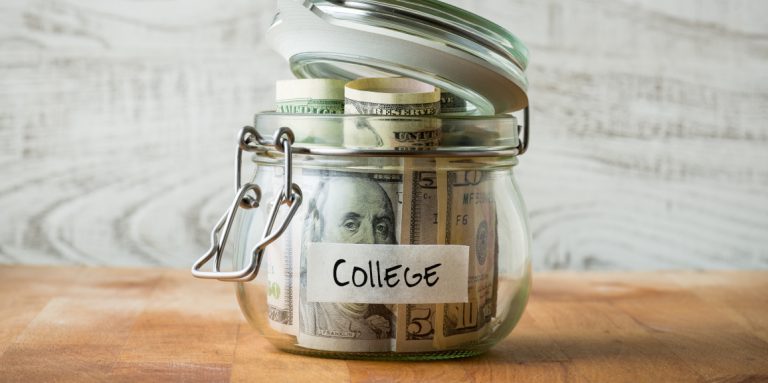If you’re heading to college, it’s time to count those coins.
The average cost of tuition and fees for a four-year public university is $23,890 a year. That’s not including other expenses, like books, room and board, or other supplies. Private schools are more than $32,000 a year.
If you want to avoid taking out student loans, you’re going to need to start saving. It’s never too early to start, and every little bit goes a long way.
Why save instead of borrow
Student loans are tremendously helpful to those who can’t otherwise afford to pay for school. It could be someone’s determining factor in being able to attend classes instead of foregoing college.
But student loans — both federal and private — come with stipulations. Even though you have the opportunity to borrow money now and pay it back later, it comes with the added burden of interest.
Interest is the added payment you must make for the benefit of borrowing. The loan principal is the original amount you borrowed. You end up paying more than your original amount due to interest — many times in the thousands of dollars.
Let’s say you borrowed a total of $30,000 for your education with an interest rate of 4.53%. If you went on the standard repayment plan of 10 years, you’d owe $7,362 in interest alone, or a total of $37,362.
And what if you had to take out private student loans? Say you got about 7.5% in interest and borrowed the same $30,000. After 10 years, you’d owe $12,733 in interest, or $42,733 total.
| Type of Loan | Borrowed Amount | Interest Rate | Interested Owed | Total Amount Owed |
| Federal | $30,000 | 4.53% | $7,362 | $37,362 |
| Private | $30,000 | 7.5% | $12,733 | $42,733 |
Even with low interest rates, the amounts add up. That’s why saving for college is vital long before you get there.
How to start saving now
Many parents who spent years repaying their own loans (or are still paying them off) are proactive when it comes to their children’s future education. Talk to your parents about savings plans and if there’s anything already in the works for your college education.
Keep in mind, though, that your parents have their own futures to worry about, and your education is very much in your hands. Whether you start school in a few months or a few years, you have plenty of ways to start saving money.
1. Open a savings account or 529 account
Before you even find ways to make money, make sure you have a place to put that cash when you get it.
Some savings accounts need to be opened with an adult, so ask a relative you trust to help you get started. There are high-yield savings accounts that offer more than 2.00% APY. Or you could try a CD or Roth IRA, if you have the time to let your money grow once it’s in there. You’ll also need an adult to open those accounts as well.
Another great option for savings is a 529 account. A 529 account offers tax-free earnings growth and tax-free withdrawals when the funds are used to pay for qualified education expenses. For college, this would include tuition, fees, books, supplies, computers and sometimes room and board. These plans are offered by individual states, and each plan is different from the other. You are not restricted to investing in your state of residence’s 529 plan. It’s worth researching the features and benefits of each state’s plan before investing.
Remember this account is just for saving for college. If you want to have extra cash for buying some meals with your friends or going to the movies, keep that money separate.
2. Get a job
You may already have a home, phone, and clothes that your family generously provides. That means if you want anything extra, you’ll need to pay for it yourself.
Use this time to find a paying job, like working at the movie theatre, grocery store, or even a smoothie cafe. You can also start working for yourself by doing things like babysitting for family and neighbors, walking dogs, mowing lawns, or cleaning homes.
Depending on what you’d like to do in college, you may find a business around town that’s willing to hire you to do the work you’d be studying for. For example, if you’re studying web development, a local firm may hire you to help build websites.
3. Explore free money options
Getting free money is your best bet to avoid student loans. You can browse grants and scholarships from around the country or those offered in your community through nonprofits or businesses looking to give back to younger generations.
Grants are usually based on need and scholarships tend to be based on merit, like really good grades or athletic skill. Take the time to review the ones you think you’d qualify for and don’t rush the process. It’s better to win a few great grants and scholarships rather than apply for many and get none.
Ask your family to start contributing to your college fund. Instead of a birthday present or holiday gift, they’ll give you cash for you to put into your college savings account. Also be open with your family about your search for grants and scholarships so they can help you find ones you should apply for.
It’s still OK if you need loans
While loans are considered a final resort — after family contributions and free money are calculated — they’re still available if you’re in need. First tap into federal student loans, due to their lower interest rates and better repayment benefits. When you apply for the Free Application for Federal Student Aid (FAFSA), your award letter will let you know what federal loans you qualify for.
Private student loans are available if you still have funding gaps for your education. But don’t choose the first lender you find. Use Purefy’s rate comparison tool to see where you’d qualify for the best rates. Since private student loans require a credit check, you may need a cosigner, like a parent or other relative, to take out a loan with you. Make sure it’s someone with a strong credit history who can vouch for you.
Regardless of how you pay for college, remember you have plenty of options. Do your best to save early, explore grants and scholarships, and tap into student loans if you fall short in your finances. Even if you only save a little bit by the time you get to college, it’s that much less you’ll need to borrow in a loan. Every little bit counts!















